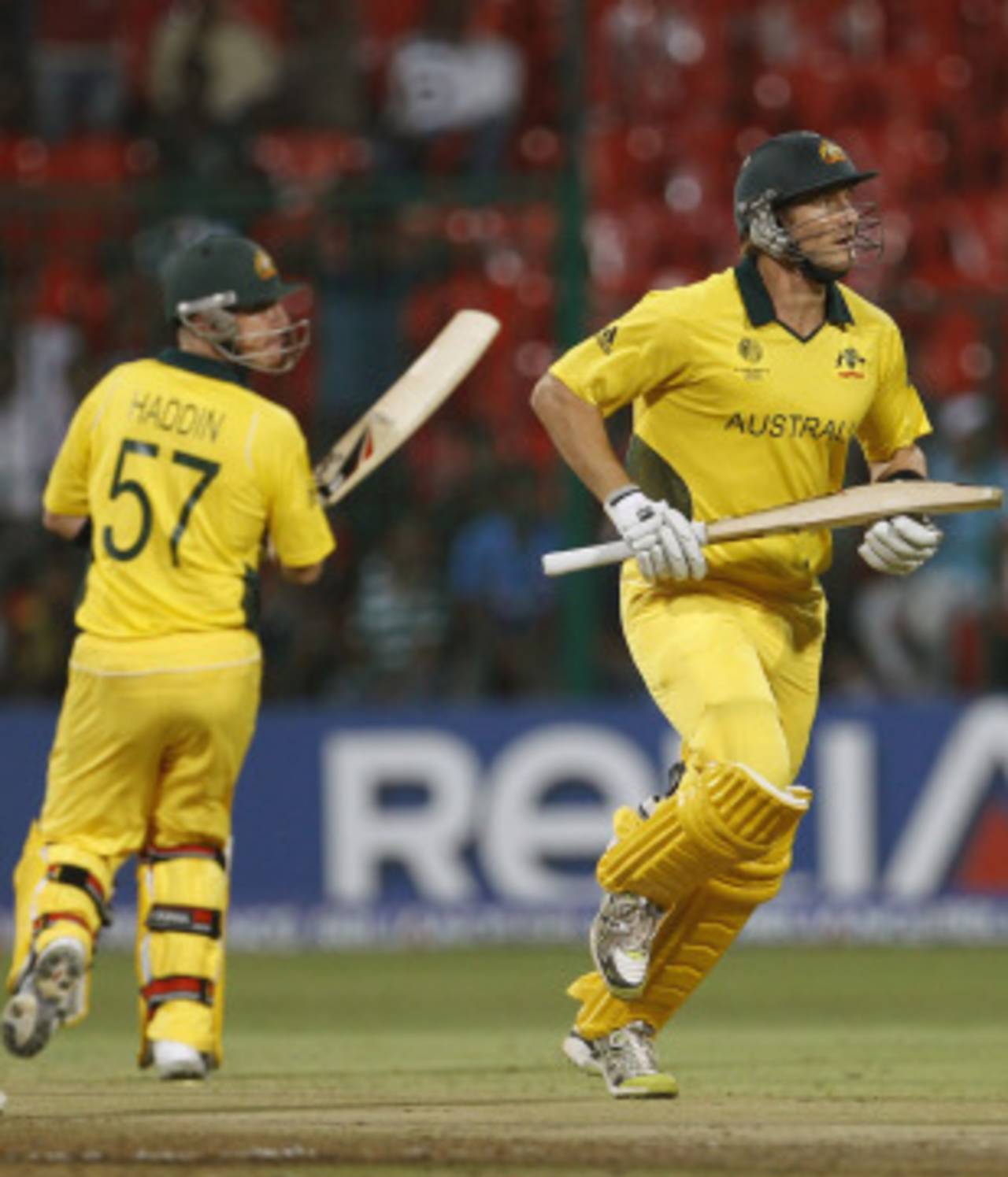Before Australia's first World Cup match, Ricky Ponting spoke of how important it was for Brad Haddin to turn his encouraging starts into match-winning hundreds. A 30 or a 50 from a top-order player, Ponting said, rarely wins a game for his team.
And Haddin, unlike his opening partner Shane Watson, hasn't made an ODI century since last March. But nor has he failed very often. Since the start of the Australian summer, Haddin has opened in 15 one-day internationals, and only twice has he scored less than 20.
Marcus North's Test manhattan showed little but skyscrapers and tiny sheds; Haddin's one-day graph is full of mid-range apartment buildings. The captain might want more tall towers, but Haddin is Australia's leading run scorer in the World Cup, and is confident that he is doing his job.
"I'm a bit different [in my thinking]," Haddin told ESPNcricinfo this week. "I think the main thing is to get the team off to a good start. Statistically, Shane and I are nearly averaging 50 with our partnerships. The important thing for me is to make sure you're setting a good platform so everyone can build on that throughout the whole game. From a personal point of view, everyone wants to score more hundreds and get the personal result, but the main thing is to be consistently setting the team up for a good platform to launch from at the end."
And in that regard, the Haddin-Watson combination is working reasonably well. Their average opening partnership is 49.50, and of all the pairs that have opened for Australia on
at least 20 occasions, only the brief Adam Gilchrist-Simon Katich liaison averaged more.
Even so, Haddin could stand to score his runs a shade quicker. Against Pakistan, he took 80 deliveries to make his 42, and the spin-heavy Zimbabwe attack kept him to 29 off 66. A more fluent Haddin was seen in the win over New Zealand, when he raced to 55, and once he eventually found his rhythm against Kenya, he finished with 84 at better than a run a ball.
"A couple of times here, I've started a bit slower because I haven't really seen the bowlers before," Haddin said. "When we played against a team like New Zealand, you know a bit more about the bowlers, and the way they're going to play. You just judge the situation on whatever gets thrown your way, and what the wicket is going to do, whether it's going to be a 300 wicket or a 260 wicket, things like that."
A feature of Haddin's game during this World Cup has been the way he backs away to give himself room to hit over the off side against the fast bowlers. When it works, it looks brilliant, but when he misses, it looks ugly and manufactured.
"I haven't been doing that quite as much in the last couple of games," he said. "It's something that you just work on with different conditions. The important thing in these tournaments is to play with freedom. We've been here a long time now and we are able to play with freedom. If we play that way and at our best, there's no one that can beat us."
That may be true if Haddin and Watson bat like they did against Canada, when they mauled the attack and put on 183 at better than a run a ball. Handling a team like India on Thursday, or Pakistan if they reach the semi-finals, is a much sterner challenge, although at his best Watson can destroy any attack.
Haddin has had a front-row seat for some of Watson's finest innings, including the unbeaten 161 he managed against England at the MCG in January. Despite his own talents and experience, Haddin is effectively the junior partner, and he knows that sometimes his role is simply to give Watson the strike.
"If you bat together for any period of extended time, you start to understand each other's game," Haddin said. "I think Watto and I complement each other. There are days when Shane is on, and you've just got to make sure you feed him the ball. If he takes a bit longer, then it's your day to maybe take a few more risks because you know how destructive he can be, the longer he bats."
The Haddin-Watson combination has been Australia's preferred opening partnership over the past two years. For a year before that, Watson and Shaun Marsh were forming a strong alliance as Australia tried to work out who would open at the 2011 World Cup.
In 2007, the decision was much more straightforward. Adam Gilchrist and Matthew Hayden headed an imposing Australian batting order that never lost more than six wickets in a match throughout the entire tournament, and nearly half the time posted 300-plus totals.
Haddin spent two months in that World Cup squad as the backup for Gilchrist. Like Mitchell Johnson, he didn't get a game, but learnt a lot about success.
"That was a wonderful experience, to be part of a whole World Cup campaign," he said. "We did have a tremendous run and an outstanding team. From a player's point of view who wasn't playing, you can't get a better education than watching the way the team prepared, watching the momentum they created through the tournament. It makes you hungry to be a part of it."
Four years later, Haddin is a key part of it. And if Australia are to make it four World Cup triumphs in a row, they'll need a few more of his good starts.
Brydon Coverdale is an assistant editor at ESPNcricinfo
